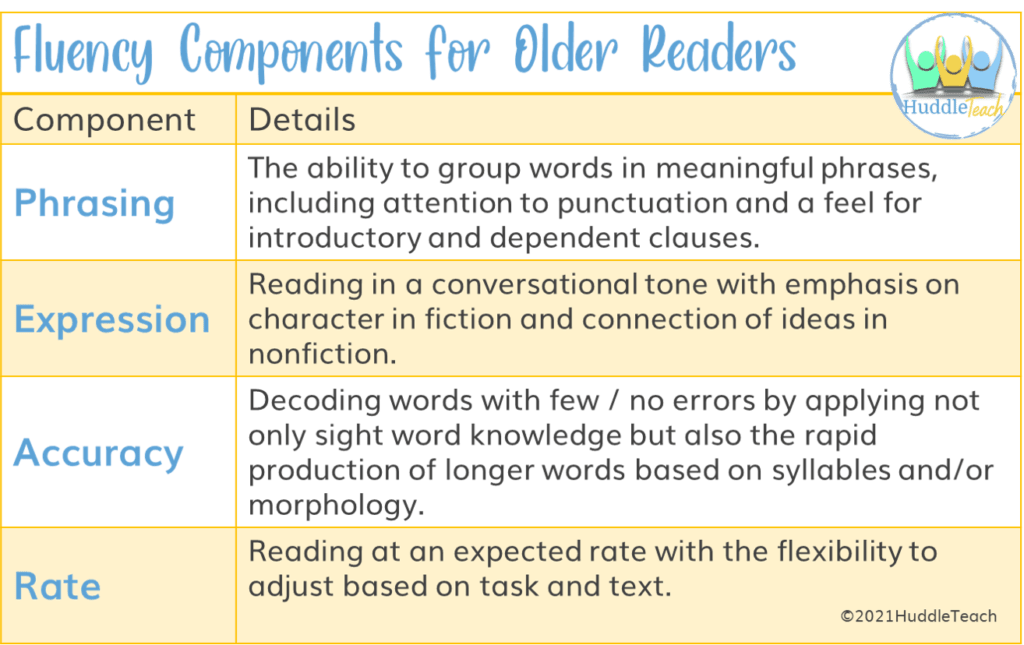What struggling readers are missing and how to help

Fluency is a focus of instruction beginning in younger grades, but it is often associated solely with decoding or word recognition and speed. As students move past the primary grades, fluency becomes even a stronger bridge to comprehension. By the time students enter middle and high school, there should be a strong understanding of all the components and nuances of this skill. If there are fluency errors, there will be a breakdown in understanding.

There are many possible errors as the depth of this skill increases. When fluency falters, so does understanding, as fluency is the bridge that connects decoding and comprehension. Here are some common fluency errors your students may be making:

Listening to students read is the only way to tell if your students are making these mistakes.
Not sure how to convince students to read aloud to you? Find out on this post.
Are your students making these fluency errors?
1. Speed Errors
One of the most common fluency errors – so much so that it should be addressed in core instruction – is the speed at which students read. Hasbrouk and Trindal provide a researched chart of reading rates with percentile indicators through sixth grade (available here), updated in 2017. Unfortunately, seventh and eighth grades were not updated; instead, use the 2006 expectations. Here’s a short version of the secondary information:

Older students should also be able to adjust their reading rate based on the difficulty and type of text. Teachers must have ongoing conversations about this flexibility as they read with students.
2. Accuracy Errors
Accuracy is the most important component of fluency. Students have to read the words the author has written to access the intended meaning. If students substitute, omit, transpose, or even mispronounce words, they will lack complete comprehension of the text. Teach students to decode longer words and monitor their reading.
One way to help students learn to monitor their accuracy is to have students read aloud to you as you watch the text. Any time the student makes an error in accuracy, tap the desk (or have another prearranged signal) without pointing out the error. When you tap, the student returns to the beginning of the sentence and rereads it. Continue on. While this seems like a simple process, it is one of the most effective for creating the habit of self-monitoring for accuracy.
3. Phrasing Errors
The other fluency error students often make is misplacing a phrase. This happens when a phrase or clause begins a sentence. For example, students will see these sentences:
Over the years, kings and queens have changed parts of the ceremony. In 1553, Queen Mary refused to be crowned sitting on the coronation chair.
Instead, students with phrasing errors say:
Over the years, kings and queens have changed parts of the ceremony in 1553. Queen Mary refused to be crowned sitting on the coronation chair.
This error changes the meaning of the text, leading to misunderstanding and a lower comprehension rate. Drawing attention to phrases and clauses begins to correct this error.
One way to do this is through phrase-cued reading. Phrase-cued reading involves making a copy of text, putting a slash (/) at phrase breaks, and two slashes (//) between sentences. The sentence above would be marked like this:
Over the years, / kings and queens / have changed parts / of the ceremony.// In 1553,/ Queen Mary / refused to be crowned / sitting on the coronation chair.//
This is more of an art than a science, and there are few rules to marking phrases besides avoid splitting within prepositional phrases. Adjust the number of phrases as your students are able. A more advanced student may have text marked like this:
Over the years, / kings and queens have changed / parts of the ceremony.// In 1553, / Queen Mary refused to be crowned / sitting on the coronation chair.//
Once students have practiced the text as marked, return the unmarked passage and read it through again. You should see a marked difference in fluency (and in comprehension)!
Practice fluency skills for growth
Even after students have mastered basic fluency components, they will need additional practice for increased growth.
If you’d like to know how to grow your Tier 1 students, assess for fluency, intervene for fluency support, and share fluency information with peers and parents, check out our Fluency FIRST Aid on-demand professional development!
Also, enter your name and email to join our community. You’ll receive a free ebook detailing reading components, and you’ll be added to our mailing list. That means once a week you’ll receiving teaching tips, freebies, and more – including more resources for improving fluency!


